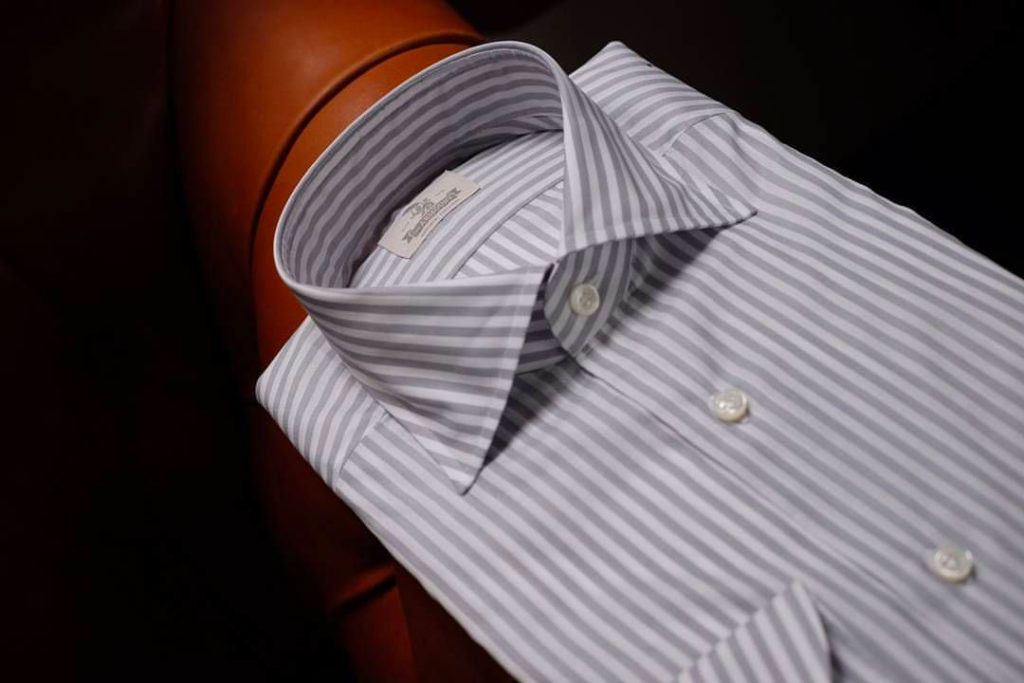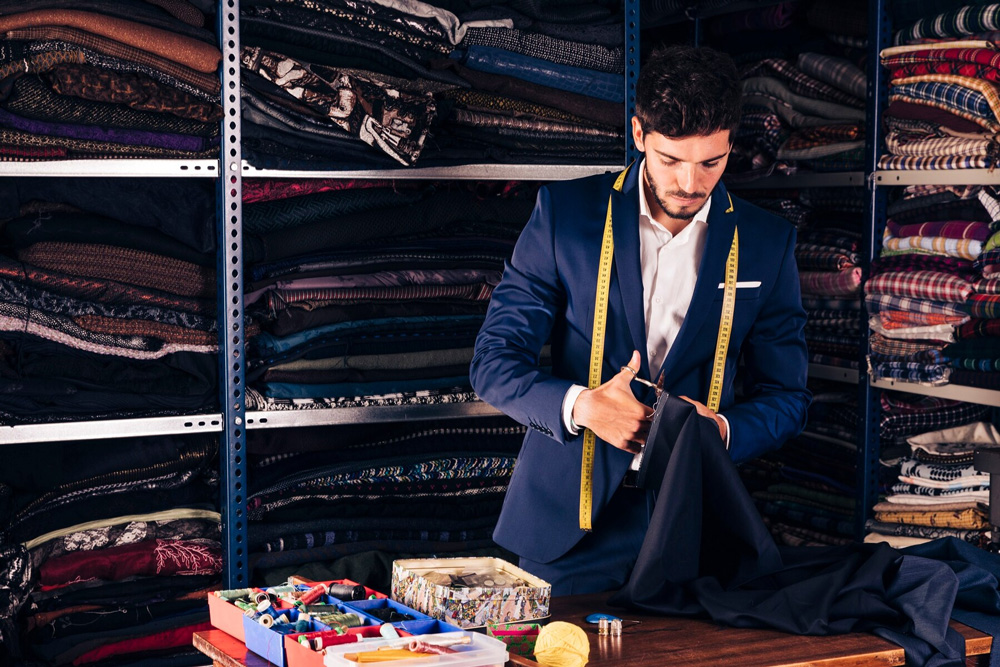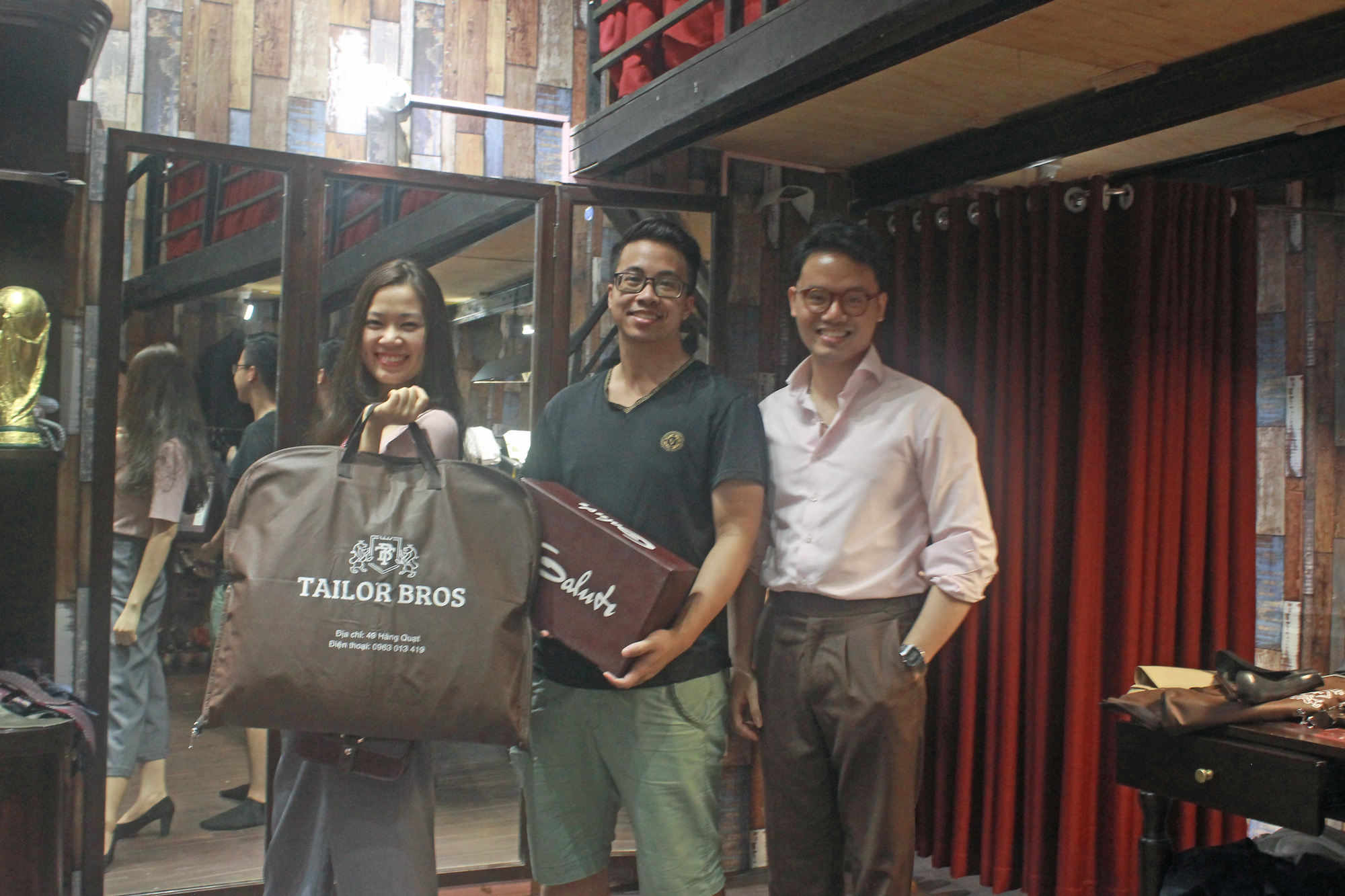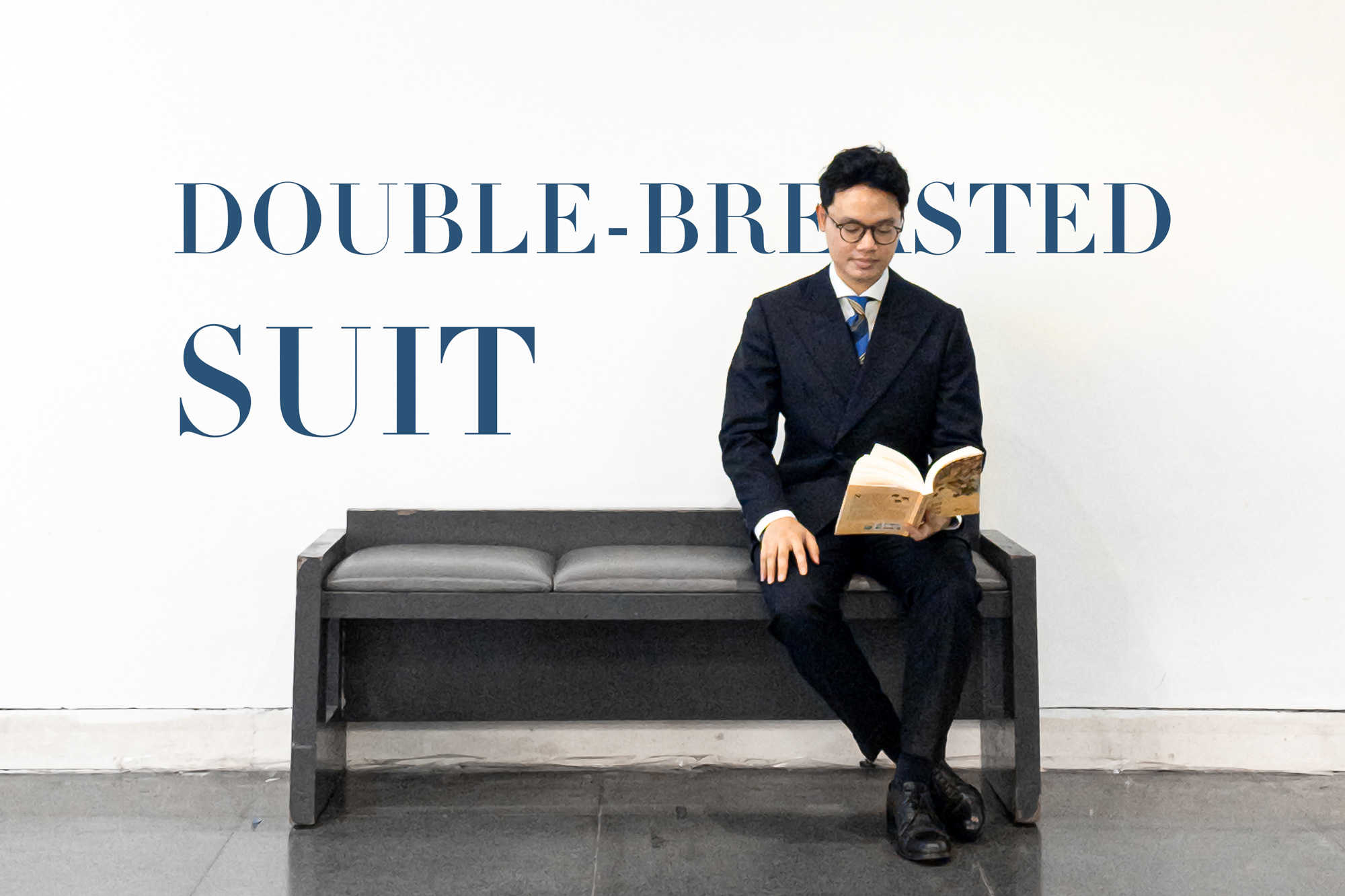Having previously covered shirting materials and hallmarks of a quality shirt, it’s now time to focus more closely on the style options of a dress shirt.
In recent years, the shirt has gradually assumed its rightful place in men’s wardrobes. Keeping up with ongoing trends and adapting itself to the shifting contours of menswear, the recent evolution of men’s dress shirts reflects not only advances in production techniques but also the growing needs and demands of a fashion-driven market. What started purely as a functional item has now been transformed into a style defining garment.
The Proper Fit of a Shirt
Arguably fit is the most striking and important feature of a shirt. If your shirt is ill-fitting, even the best interlinings, the finest details and the best collar style for you won’t matter because it looks bad.
No matter what option you chose, the fit and the style options you choose the final fit will have a huge impact on the overall look. People often talk about the “perfect fit” as if it was one objective standard, but in fact, it contains many subjective elements. So first of all, you have to determine what fit and look you like. You can choose between Classic Fit, Slim Fit, Modern/Contemporary Fit, and Skinny Fit.
The Classic Fit – Best For Comfort
The classic fit is likely what your father and grandfather wore. It is characterized by a traditional tailoring silhouette, allowing a comfortable feel with a boxier shape, with plenty of fabric in the sleeves and the body. It provides great mobility and features two vents on the back, usually located near the yoke. Back in the day, a gentleman would never wear a shirt without a jacket, and often a vest, and therefore the main priority was comfort.This is the go-to choice for those with a more classic style who favor comfort over fashion.

If you wear your shirts with jackets, this is probably the best fit for you because it is the most comfortable. It is not the best choice for slim chaps because other styles may suit you better. However, if you have a rounder stomach, this is the most comfortable and most flattering style for you.
Slim Fit – Best For Looks If You Are Slim
Throughout history, young men have often tried to differentiate their look from their parents. At the same time, it has become socially acceptable to wear a dress shirt without a jacket, and therefore the look and fit of the shirt itself has become more important.

While a slim fit shirt is less comfortable and often more constricting in your movement, it is a lot more fashionable because it eliminates excess fabric.
A slim fit shirt typically has an accentuated back with darts and a high armhole stance allowing for a shaped look that sits closer to the body, without being skin tight.
As the name implies, this shirt fit is made for slim people, therefore please do not choose it if you have some love handles or a belly because it looks really bad, if you are not in shape.
If you are in shape and young or young at heart, and you want to wear the shirt on its own and look the part, the slim fit look is for you.
The Modern/Contemporary Fit – Best of Both Worlds
The Modern Fit sits in between the classic and the slim fit, providing the best of both worlds when it comes to comfort and style. A slightly tapered silhouette with the waist sometimes in combination with small back darts create a trimmer look than the classic fit that looks good even without a jacket without sacrificing comfort. The armholes are high, the sleeves have some room but are not too wide, and the yoke extends to or just past the shoulder bone.

This is my preferred shirt fit because I do not have to limit my range of movement, but I look slimmer than in a classic shirt. Even though I wear a jacket most of the time, I could even wear the shirt without a jacket. If you are not the slimmest guy, but you don’t have a huge belly, this fit suits you best. Of course, you can also wear it as a slim chap.
Super Slim/Skinny Fit – Stay Clear Unless You Are Skinny
This super slim or skinny fit is mostly popular with young men who think that tighter is better. In practice, this fit is usually characterized by lots of wrinkles, and unless you have a very skinny body that justifies it, you should avoid it altogether. Skintight shirts are not a flattering alternative for anyone, and they restrict your range of movement considerably. If you are interested in classic men’s style, stay clear of this fit.

Shirt Style Details Explained
It’s important to keep in mind that style is very personal and subjective. As such, this guide is meant to help you find the style elements that are best for you while highlighting the purpose or the traditions behind it.
No matter, if you’re looking at a RTW, MTM or bespoke shirt, these guidelines apply to all of them.
Shirt Front – To Have A Pocket Or Not
Aside from the shirt placket, most shirts feature a plain front without any additional elements other than chest pockets. Modern shirts sometimes feature darts or decorative stitching, but that’s not classic.
No Pockets = Formal
Some men like to have a shirt pocket; others don’t. Historically, a shirt with a pocket was always less formal, than one without, because a gentleman did not have to work and would wear a jacket as such, he would have never used his shirt pocket.
1 Pocket = Informal
On the other hand, someone engaged in physical labor used the pocket to store things while working. Today, it looks odd to have items or a pen clip to a chest pocket, as such it is more of a stylistic choice. As a rule of thumb, I never add them to formal shirts, and sometimes to more casual shirts.
2 Pockets = Very Informal
A chest pocket on both sides is very casual and usually reserved for very informal shirts such as safari, military or western shirts.
Tuxedo & Evening Shirts – For Special Occasions
If you attend a black tie event or even a white tie gala, you should wear a designated evening shirt. Traditionally, these formal shirts feature lots of details and we will post a designated guide about them at a later time, however here are the key points:
- Black Tie Shirt
- White cotton fabric – Solid or micropattern
- Soft turndown collar – classic collar, not too spread
- Front bib either pleated or piqué / marcella
- Soft French Cuffs
- Alternative:
- White tie shirt with detachable stiff collar
- Stiff single cuffs for cufflinks
- Marcella or stiff bib front
- To be worn with white marcella piqué vest
it is usual for shirts to present a bib-like contrast in the front. This so-called “tuxedo shirt” is not meant for everyday wear and should be saved for the occasion. The contrasting fabrics on the bib are usually heavier and feature a pleated or pique effect. This type of detailed front, when taken out of the original context, has also enabled designers to create bold statement pieces making use of contrasting elements of both color and pattern.

Shirt Placket – It’s Your Choice
The placket is one of the main elements of the shirt’s front, because it automatically draws attention to itself due its central position.
Traditional Placket
Also known as the “American placket” due to the strong influence and representation of American style, this is the most conventional style of all. It adds symmetry to a dress shirt, and it is basically, a separate piece of fabric attached to the shirt front. It can either by be folded or stitched, and it is a popular option for everyday business shirts, but you can also find them on traditional American Oxford Cloth Button Down shirts.
The French Placket
The French placket is a more polished alternative than the traditional placket, and therefore it is the choice for evening shirts.
It is a very simplistic style that is achieved by folding the fabric over itself inwards. This technique results in a clean shirt front without any stitching. As the name implies, it is associated with a European aesthetic and the go-to choice for a more modern debonair look. Although traditionally more formal, the French placket can be worn with classic, fashion or casual shirts today.
The 3/4 Placket
This placket is slightly longer than on a polo shirt and does not reach all the way down. As such, you have to pop it over your head, and therefore it is only seen on more relaxed shirts or popover shirts. Some men like them for a relax, casual summer look in combination with linen fabrics.
The Fly Front Placket
Originally the fly front placket was a modern take on an evening shirt placket without any shirt studs. It features an extra flap of fabric which conceals the buttons thus providing a cleaner looking shirt. At the end of the day, it is still a poor man’s alternative to an evening shirt, and even though some fashion brands have utilized this placket in regular dress shirts, you better stay clear of it, if you want a timeless shirt wardrobe.
Back of the Shirt – Darts & Pleats Are Optional
Apart from pleats or darts, you don’t have to many functional options in the back. Shoulder or center back pleats help to guarantee a large range of movement in your arms, but some men also like them for the looks. , as they usually do not translate into considerable alterations on the shape of the shirt. Back darts, however, depending on their width, can produce a pronounced cinched effect on the waist that makes it slimmer and more contemporary. As with most details on the shirt, it all comes down to personal taste, although achieving a slim silhouette without resorting to back pleats might not be the easiest of tasks.

Back darts can help to achieve a trim silhouette and getting rid of excess fabric. They come in particularly handy for men with an hourglass shape such as body builders. As with most details on the shirt, it all comes down to personal taste.
The Split Yoke Helps To Align The Pattern
Today, most RTW shirts have a one piece yolk because it is less expensive than a split piece yoke. The latter can help to align patterns on the shoulder sleeve seam and on a bespoke shirt, it can be used to correct sloping shoulders. Apart from that it also looks dapper if stripes perfectly meet at an angle.

The Hanger Loop = Practical
It’s just a loop on the inside of the shirt. While it is a trademark of Americana style and commonly found on casual oxford button downs, it can be just as useful in a dress shirt, especially if you work out at the gym before for after work.
Collar Options
The collar is arguably the core of the shirt as it is most visible and it can enhance the wearer’s face. While you can design a collar of your choice with bespoke shirts, even the RTW and MTM industry offers hundreds of different choices. While everyone tries to come up with a naming convention for collars a medium spread collar from one company may look very different than a medium spread collar from another. Therefore names have little meaning these days.
What used to consist of a “simple” choice of collar tip length or angle, and the desired amount of tie gap has now gotten a lot more complex due to curvy lines, button down collars with extra roll, etc.
On top of that you can now choose the stitch distance from the edge, different versions of fused and non-fused interlining, as well as the collar height, you end up with unlimited options.
At the end of the day, you can break it down to 7 essential collars which are the basis of all others: spread, button-down, club, classic, tuxedo, Mao and the small collar.
Of course, there are numerous variations in size and shape to all these collars, and while some people prefer to have the exact collar style for all their shirts, others want to mix it up and choose different collars for different occasions.
Classic collars are neither too huge nor too tiny, and they do not have extreme lengths and angles, thus making them more timeless than others. If you want to wear your shirts for years to come, avoid the extremes and don’t fall for the super spread collar and go with a semi spread instead or just take a regular button down rather than a small one.
At the same time, if you already have 60 shirts in your closet and you want something else, go and experiment! On a true bespoke shirt, you should always be able to define every element of the collar without having to choose from a set menu of collars.

The basic collars are:
- Button-down collar – apart from a couple of exceptions, all my oxford shirts feature a button-down collar. Traditionally not really worn with ties, many men now combine it with a tie — it’s all up to you;
- Classic collar – the timeless pointed collar with the right tie gap is mandatory in every man’s wardrobe;
- Club collar – a revivalist model with rounded corners that picks up the Mad Men/Boardwalk Empire aesthetic. A different spread can create a very different look and it looks great with acollar pin.
- Small collar – a smaller and more modern approach to the classic collar, this model seamlessly works with a variety of shirts from denim to oxfords and even contemporary classics, but it is often difficult to wear it with a tie or bow tie;
- Evening collar – Traditionally, evening collars were detachable, starched and stiff. Today, most tuxedo shirts feature an attached wing collar that is often too small and floppy. Either wear a turn-down collar with your tuxedo or go with a real detachable collar; for white tie, only wear a detachable collar;
- Mao collar – this standup collar is usually only worn in combination with a Nehru jacket, often by conductors or artists. Personally, I never wear it, but it is a distinct style.

Shirt Cuff Styles – Cufflinks or Buttons?
When it comes to cuff, the big question is, do you want barrel cuff with buttons or a French cuff for cufflinks?
French Cuff – The Gentleman’s Choice
Traditionally, French cuffs are dressier and more formal, allowing men to sport one of the quintessential pieces of jewelry in men’s style: cufflinks. Because this accessory makes a personal statement and expresses the wearer’s style, French cuffs have become quite popular in recent years, and they are not just reserved for formal shirts. To top it off, believers in the Italian Sprezzatura have found used these cuff to break conventional rules, by wearing them unfastened and often folded back over the jacket sleeve.
If you wear formal outfits such as a 3-piece suit or a tuxedo, cufflinks are a must-have accessory!
Barrel Cuffs – Great for Summer & Relaxed Outfits
Barrel cuffs, on the other hand, are the everyday choice for most men and the most commonly found alternative. With a variety of shapes and designs, ranging from faceted, rounded, straight, etc. up to the number of buttons, barrel cuffs provide a wide range of choices to the wearer, with a much more practical approach than their French counterparts. One critical aspect to bear in mind when considering the type of cuff to choose is its height: traditional (outdated) cuffs usually sit between 7.5/8cm, whereas contemporary classic cuffs are about 6 cm and anything less is on the more fashionable side.
Personally, I wear cufflinks about 75% of the time. I try to avoid them when wearing very casual ensembles and when it is very hot because the double layer of fabric covering your wrists makes you feel hotter in warmer climates.
Although cuffs are a crucial component on their own, they should harmonize with the collar. Depending on what combination of cuffs and collar you choose, the feel of the shirt may be anything from fashion forward, relaxed, classic to even formal. Overall, there are probably hundreds of variations with one, two or three buttons or a mix of cuff shapes like the James Bond Cuff.
Careful, Sleeve Length
If you wear a lot of jackets with shirts from different manufacturers or tailors, you’ll notice that the shirt sleeve length and the amount of cuff you show varies depending on the cut of the armholes of the shirt and the jacket. To prevent that, you can have 6 or 8 buttonholes instead of the usual 4 on a French cuff, so you can easily adjust the shirt length to the jacket. In England, they sometimes come with 6 buttonholes by default and it can be a very useful feature indeed.
The Shirt Hem
The bottom hem can also say much about a shirt’s style, namely if it leans toward the more classic or relaxed end of the spectrum.
Classic Hem – Must Be Tucked In
A classic dress shirt is worn tucked in. Therefore the tail and front hems are longer than the sides, so it doesn’t come untucked during the day. Unfortunately, many RTW shirts today are cut shorter because it helps to reduce the amount of fabric used. However, that’s a pity for the wearer as the shirt will come untucked lightly.
Although tails have gotten shorter in recent years, the design must still ensure the functional aspect, which makes the ratio between the lower and higher ends of the tail a critical variable.
Straight Hem – Best Worn Untucked
If you are looking for a casual shirt that you can wear untucked on a more relaxed occasion, straight hems are the way to go. Unlike the tail-shaped version, straight hems make the shirt much more prone to becoming untucked on its own as a result of natural body movements, so caution is advised when choosing the length: too short will look weirs, whereas too long will just look ridiculous if worn untucked.

Contrasting Shirt Elements
With the rise of online MTM shirts, contrasting collar undersides, shirt plackets, buttonholes or cuff linings have become quite popular. Since most of the rack shirts, do not have these loud customizations to appeal to a broader market, it is a way for people to show that they had their shirt custom-made for them.
Just like with anything in classic men’s style being flashy is not well-dressed, and if you strive for an elegant look, it’s best to keep these contrasting details to a minimum rather focussing on the form of the shirt details as well as the fabric and of course the proper fit.
Therefore, use them wisely and sparingly. They can elevate a casual shirt to a new standard, but the second you go overboard you look like a gaudy clown at best. Contrasting elements work best when used with subtlety. That means they are in the background while the rest of the shirt shines until it’s time for them to make a memorable appearance. Just choosing a change of thread color has a huge impact on the overall look and feel of the shirt.
White Collars & Cuffs Are Classic
A classic in menswear is the contrasting White Collar or White Collar and Cuffs. It elevates a shirts formality and makes it more business appropriate. Avoid using other contrast colors or patterns as it looks gaudy. While it looks dapper to just have a white collar and matching shirt cuffs, it doesn’t work the other way round.
Conclusion
As you can see, the look and feel of a shirt is not just defined by your choice of fabric and the details alone but also heavily by the style choices you make.
If you buy off the rack, all of these choices have been made for you, which is easy but at the same time limiting. Once you switch to a custom shirt, you have to carefully consider all the options, so everything works together once you get the shirt back
Source: Gentleman's Gazette











